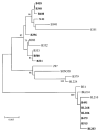Disease severity in a murine model of lyme borreliosis is associated with the genotype of the infecting Borrelia burgdorferi sensu stricto strain
- PMID: 12198612
- PMCID: PMC2773673
- DOI: 10.1086/343043
Disease severity in a murine model of lyme borreliosis is associated with the genotype of the infecting Borrelia burgdorferi sensu stricto strain
Abstract
The pathogenicity of Borrelia burgdorferi sensu stricto clinical isolates representing 2 distinct ribosomal DNA spacer restriction fragment-length polymorphism genotypes (RSTs) was assessed in a murine model of Lyme disease. B. burgdorferi was recovered from 71.5% and 26.6% of specimens from mice infected with RST1 and RST3 isolates, respectively (P<.0001). The average ankle diameter and histologic scores for carditis and arthritis were significantly higher after 2 weeks of infection among mice infected with RST1 isolates than among those infected with RST3 isolates (P<.001). These clinical manifestations were associated with larger numbers of spirochetes in target tissues but not with the serum sensitivity of the individual isolates. Thus, the development and severity of disease in genetically identical susceptible hosts is determined mainly by the pathogenic properties of the infecting B. burgdorferi isolate. The RST1 genotype is genetically homogeneous and thus may represent a recently evolved clonal lineage that is highly pathogenic in humans and animals.
Figures






Similar articles
-
Coinfection with Borrelia burgdorferi sensu stricto and Borrelia garinii alters the course of murine Lyme borreliosis.FEMS Immunol Med Microbiol. 2007 Mar;49(2):224-34. doi: 10.1111/j.1574-695X.2006.00177.x. FEMS Immunol Med Microbiol. 2007. PMID: 17328756
-
Isolation of moderately infectious Borrelia burgdorferi sensu stricto from attenuated cultures by using complement-mediated, antibody-dependent lysis selection technique in a mammalian tissue co-culture system.Microbes Infect. 2003 Aug;5(10):869-78. doi: 10.1016/s1286-4579(03)00178-3. Microbes Infect. 2003. PMID: 12919855
-
Borrelia burgdorferi RST1 (OspC type A) genotype is associated with greater inflammation and more severe Lyme disease.Am J Pathol. 2011 Jun;178(6):2726-39. doi: 10.1016/j.ajpath.2011.02.018. Am J Pathol. 2011. PMID: 21641395 Free PMC article.
-
Molecular typing of Borrelia burgdorferi sensu lato: taxonomic, epidemiological, and clinical implications.Clin Microbiol Rev. 1999 Oct;12(4):633-53. doi: 10.1128/CMR.12.4.633. Clin Microbiol Rev. 1999. PMID: 10515907 Free PMC article. Review.
-
The need to unravel the twisted nature of the Borrelia burgdorferi sensu lato complex across Europe.Microbiology (Reading). 2020 May;166(5):428-435. doi: 10.1099/mic.0.000899. Microbiology (Reading). 2020. PMID: 32125267 Review.
Cited by
-
Unexpected failure of Ixodes scapularis nymphs to transmit a North American Borrelia bissettiae strain.Curr Res Parasitol Vector Borne Dis. 2021 Jul 3;1:100039. doi: 10.1016/j.crpvbd.2021.100039. eCollection 2021. Curr Res Parasitol Vector Borne Dis. 2021. PMID: 35284869 Free PMC article.
-
Multilocus sequence typing of Borrelia burgdorferi suggests existence of lineages with differential pathogenic properties in humans.PLoS One. 2013 Sep 17;8(9):e73066. doi: 10.1371/journal.pone.0073066. eCollection 2013. PLoS One. 2013. PMID: 24069170 Free PMC article.
-
Borrelia burgdorferi Strain-Specific Differences in Mouse Infectivity and Pathology.Pathogens. 2025 Apr 5;14(4):352. doi: 10.3390/pathogens14040352. Pathogens. 2025. PMID: 40333117 Free PMC article.
-
Borrelia burgdorferi genotype predicts the capacity for hematogenous dissemination during early Lyme disease.J Infect Dis. 2008 Nov 1;198(9):1358-64. doi: 10.1086/592279. J Infect Dis. 2008. PMID: 18781866 Free PMC article.
-
Relapsing fever spirochetes contain chromosomal genes with unique direct tandemly repeated sequences.Infect Immun. 2005 May;73(5):3025-37. doi: 10.1128/IAI.73.5.3025-3037.2005. Infect Immun. 2005. PMID: 15845510 Free PMC article.
References
-
- Centers for Disease Control and Prevention. Lyme disease—United States, 2000. MMWR Morb Mortal Wkly Rep. 2002;51:29–31. - PubMed
-
- Nadelman RB, Wormser GP. Lyme borreliosis. Lancet. 1998;352:557–65. - PubMed
-
- van Dam AP, Kuiper H, Vos K, et al. Different genospecies of Borrelia burgdorferi are associated with distinct clinical manifestations of Lyme borreliosis. Clin Infect Dis. 1993;17:708–17. - PubMed
-
- Wormser GP, Liveris D, Nowakowski J, et al. Association of specific subtypes of Borrelia burgdorferi with hematogenous dissemination in early Lyme disease. J Infect Dis. 1999;180:720–5. - PubMed
Publication types
MeSH terms
Substances
Grants and funding
LinkOut - more resources
Full Text Sources
Other Literature Sources
Medical

